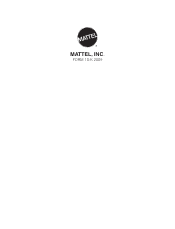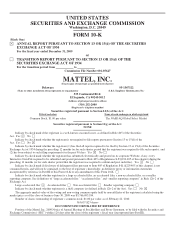Mattel 2009 Annual Report Download - page 19
Download and view the complete annual report
Please find page 19 of the 2009 Mattel annual report below. You can navigate through the pages in the report by either clicking on the pages listed below, or by using the keyword search tool below to find specific information within the annual report.Backlog
Mattel ships products in accordance with delivery schedules specified by its customers, which usually
request delivery within three months. In the toy industry, orders are subject to cancellation or change at any time
prior to shipment. In recent years, a trend toward just-in-time inventory practices in the toy industry has resulted
in fewer advance orders and therefore less backlog of orders. Mattel believes that the amount of backlog orders at
any given time may not accurately indicate future sales.
Financial Instruments
Currency exchange rate fluctuations may impact Mattel’s results of operations and cash flows. Mattel seeks
to mitigate its exposure to market risk by monitoring its foreign currency transaction exposure for the year and
partially hedging such exposure using foreign currency forward exchange contracts primarily to hedge its
purchase and sale of inventory, and other intercompany transactions denominated in foreign currencies. These
contracts generally have maturity dates of up to 18 months. In addition, Mattel manages its exposure to currency
exchange rate fluctuations through the selection of currencies used for international borrowings. Mattel does not
trade in financial instruments for speculative purposes.
For additional information regarding foreign currency contracts, see “International Segment” above,
Item 7A “Quantitative and Qualitative Disclosures About Market Risk” and Item 8 “Financial Statements and
Supplementary Data—Note 11 to the Consolidated Financial Statements—Derivative Instruments.”
Seasonal Financing
See Item 8 “Financial Statements and Supplementary Data—Note 8 to the Consolidated Financial
Statements—Seasonal Financing and Debt.”
Government Regulations and Environmental Quality
Mattel’s toy products sold in the US are subject to the provisions of the Consumer Product Safety Act, the
Federal Hazardous Substances Act, and the Consumer Product Safety Improvement Act of 2008, and may also be
subject to the requirements of the Flammable Fabrics Act or the Food, Drug, and Cosmetics Act, and the
regulations promulgated pursuant to such statutes. These statutes ban from the market consumer products that fail
to comply with applicable product safety regulations. The Consumer Product Safety Commission (“CPSC”) may
require the recall, repurchase, replacement, or repair of any such banned products or products that otherwise
create a substantial risk of injury and may seek penalties for regulatory noncompliance under certain
circumstances. Similar laws exist in some states and in many international markets.
Mattel maintains a quality control program to help ensure compliance with various US federal, state, and
applicable foreign product safety requirements. Nonetheless, Mattel has experienced, and may in the future
experience, issues in products that result in recalls, withdrawals, or replacements of products. A product recall
could have a material adverse effect on Mattel’s results of operations and financial condition, depending on the
product affected by the recall and the extent of the recall efforts required. A product recall could also negatively
affect Mattel’s reputation and the sales of other Mattel products. See Item 1A “Risk Factors—Factors That May
Affect Future Results” and Item 8 “Financial Statements and Supplementary Data—Note 4 to the Consolidated
Financial Statements—Product Recalls and Withdrawals.”
Mattel’s advertising is subject to the Federal Trade Commission Act, The Children’s Television Act of
1990, the rules and regulations promulgated by the Federal Trade Commission, and the Federal Communications
Commission, as well as laws of certain countries that regulate advertising and advertising to children. In addition,
Mattel’s websites that are directed towards children are subject to The Children’s Online Privacy Protection Act
of 1998. Mattel is subject to various other federal, state, local and international laws and regulations applicable to
its business. Mattel believes that it is in substantial compliance with these laws and regulations.
9
























